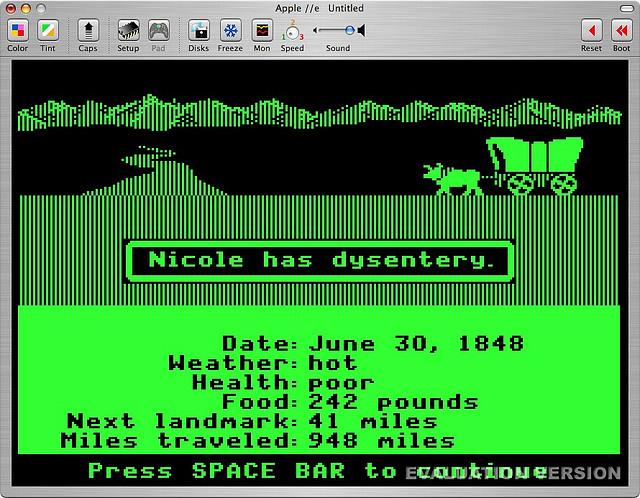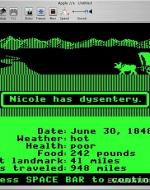Created by Colin Schroyer on Mon, 05/06/2024 - 08:22
Description:
The Oregon Trail is a classic video game that has been ported, adapted, and remade on a variety of consoles and devices since its original release in 1971. The game, developed by Minnesota Educational Computing Consortium (MECC), was intended as a way to teach 8th grade students American history - specifically about the titular Trail. But what would these students learn from a video game? Well, about the settlers who travelled along the trail and the mass migration to the west. Encyclopedia Britannica says "[The Oregon Trail] was one of the two main emigrant routes to the American West in the 19th century, the other being the southerly Santa Fe Trail from Independence to Santa Fe... The Oregon Trail, which stretched for about 2,000 miles (3,200 km), flourished as the main means for hundreds of thousands of emigrants to reach the Northwest from the early 1840s through the 1860s."
Historical testimonies of life on the Trail correlate rather closely to the actions taken in the game. In a collection of accounts from the time period by John Minto, several descriptions of life on the trail are presented. For example, Minto recounts one moment at the start of their journey: "[An Irishman] gave such dressed skins as I had taken (ten of) for my gun, for three rifle charges of powder and lead each. That means, I gave a gun needing a twenty-five cent repair, more valuable than any rifle for killing buffalo on the run, for thirty charges of ammunition; and I am told this is three times the cost of the skins to Mr. Bridger" (209). This initial interaction and bartering in his journey reflects the mechanics of the game; trading, purchasing food and ammunition, and random encounters are all elements of the game that one can experience (The Oregon Trail). Though the game truncates the drudgery and toil of travelling thousands of miles across a country over the span of several months to some loading time and moving pixels, the strategy component to the game (as well as the random events that can befall your party of travelling pioneers) in many ways does present an adequate glimpse into the life of those living on the Oregon Trail. The image provided is a moment from the original MS-DOS game, including an infamous component of the game: the tendency for a party member to catch dysentry. The image itself does not reveal much about the grander progress of American growth through the Oregon Trail, but it represents the game, which in turn encapsulates the Manifest Destiny mentality which spurred on so many brave individuals and families to brave the wilderness and expand the country.
The Oregon Trail represents progress in the United States in two crucial ways: first is its subject matter; the Oregon Trail paved the way for the United States' expansion into the western half of the continent. Second, The Oregon Trail the game helped to pioneer (pun fully intended) the burgeoning medium of video games, which will soon grow into one of the most predominant and popular entertainment mediums and industries in the United States.
Works Cited:
Hill, William E.. "Oregon Trail". Encyclopedia Britannica, 28 Mar. 2024, https://www.britannica.com/topic/Oregon-Trail. Accessed 6 May 2024.
Minto, John. “Reminiscences of Experiences on the Oregon Trail in 1844.--II.” The Quarterly of the Oregon Historical Society, vol. 2, no. 3, 1901, pp. 209–54. JSTOR, http://www.jstor.org/stable/20609503. Accessed 6 May 2024.
The Oregon Trail. MS-DOS version, MECC, 1971. Internet Archive, https://archive.org/details/msdos_Oregon_Trail_The_1990. Accessed 6 May, 2024.


